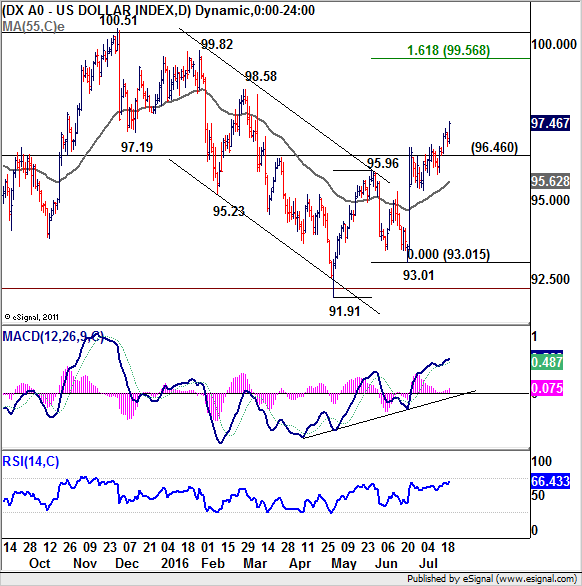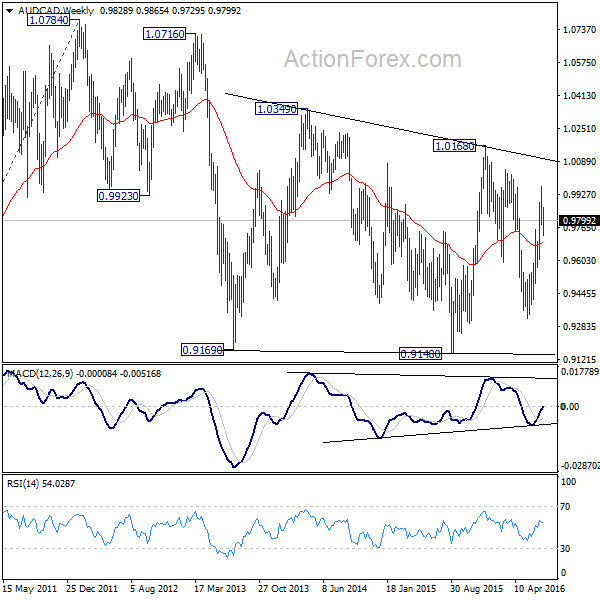Dollar ended the week broadly higher on reviving expectation that Fed is still on course for rate hike this year. The dollar index broke out of recent range and jumped to close at 97.46. The movement was supported by strength in US equities with DJIA and S&P 500 extending the record runs, even though with diminishing momentum. On the other hand, commodity currencies ended the week broadly lower. Aussie and Kiwi were pressured by expectation of rate cut by respective central banks in August. Canadian dollar was dragged down by WTI crude oil which closed below 45 handle at 44.26. Yen followed as the third weakest currency on speculations of policy easing by BoJ in spite of confusing media reports on the topic.
FOMC and BoJ monetary policy meetings will be the major focuses this week. There is very little chance for Fed to hike interest rate this time. But markets will be keen to scrutinize the statement on whether Fed is now comfortable to move in September. Currently, fed fund futures are pricing in 15% chance of hike by September and 47% chance by December. Recent comments from Fed officials argued that policy makers generally didn't expect Brexit to have a large impact on the US economy. And business would gradually return to usual in Fed. But since there will be no press conference this time, markets could be disappointed by the lack of hints in the statement. Instead, the focus could turn to minutes to be released on August for more information on the views among the FOMC members. Other than that, US will also release Q2 GDP on Friday.
Recent reports on BoJ's stance on monetary policy ahead has been a bit confusing. Governor Haruhiko Kuroda somehow tried to clarify the stance with a speech on Saturday. Kuroda maintained the pledge that "we will check risks in the economy and prices and expand monetary stimulus if it's needed to achieve our price stability target at the earliest time possible." But "if the words 'helicopter money' mean the direct underwriting of government debt or managing fiscal and monetary policy as one consolidated measure, that is forbidden in developed nations -- including Japan -- from the lessons of history." That's clearly not helping the market participants. Meanwhile, there were talks that BoJ would ease this week as part of the "policy mix" with the fiscal stimulus to be announced by prime minister Shinzo Abe. But there were also talks that BoJ would wait for BoE and possibly even ECB to act first before moving themselves. So, the result of BoJ meeting this week, one way or the other, could be quite market moving.
Last week's rally in dollar index affirmed the bullish case that rise from 91.91 is gather momentum again. As noted before, consolidation pattern from 100.39 should have completed with three waves down to 91.91 already. Further rise should be seen to 161.8% projection of 91.91 to 95.96 from 93.01 at 99.56, and then 100.39/51 resistance zone. However, the break of 100.51 will likely need a string of strong data, like NFP, to solidify the case for Fed hike. Otherwise, dollar index could struggle to find sustained buying at around 100. In any case, near term outlook will stay cautiously bullish as long as 96.46 minor support holds.

Regarding trading strategy, we sold GBP/USD on break of 1.3103 last week. There was intra-week recovery but GBP/USD was knocked down by weak UK PMIs again. We'll hold to the view that corrective rebound from 1.2794 has completed at 1.3480 already and downside breakout could be seen in near term. So, we'll stay short in GBP/USD for first target of 1.2794. Stop will now be put close to last week's high at 1.33.
With the expectation of further dollar strength, we'd like to sell another major currency against the greenback this week. EUR/GBP turned into sideway trading after hitting 0.8626 and the relative strength among the two could be neutral in near term. Since we've got GBP/USD short already, we'll tend not to sell EUR/USD. USD/JPY's move last week was indecisive despite a breach of 106.78 and there is risk of BoJ and so we prefer to avoid this pair.
AUD/CAD stayed in the sideway pattern since 0.9169 and is close to upper side of the range, with risk of reversal. That is, while both Aussie and Canadian might weaken against the greenback, Aussie might start to underperform Canadian. AUD/USD's fall last week also suggests that recent rebound from 0.7144 has completed at 0.7675 already. Hence we'll sell AUD/USD this week for 0.7304 support first and then a test on 0.7144.

